ABSTRACT
Among the vegetables, tomato is considered the essential culinary crop and also an excellent source of many nutrients and secondary metabolites. In Myanmar, tomato is grown in about 112,525 ha with a total production of 1,300 thousand MT in 2016-2017. The study was done to observe the tomato production and marketing by using the strength, weakness, opportunity and threat (SWOT) analysis in Ottarathiri, and Dekkhinathiri Township in Nay Pyi Taw. Field survey to 20 tomato farmers and 7 market stakeholders was done in December 2017. Workshop for SWOT Analysis and Policy Dialogue together with all stakeholders was held at Yezin Agricultural University (YAU) on December 28, 2017. The sample respondents had an average of 25 years of experience in tomato production. Most of the respondents had middle education level. Kyaukme (Traditional) variety was sown by 89% of samples because of high yield. Farmers sold tomatoes directly to local wholesalers by connection with the buyers before selling the product. All sample farmers sold tomatoes immediately after harvesting with cash down payment system. The weighting system used in selling tomato is Viss (1 viss = 1.63kg). The cost for packaging was paid by farmers and local wholesaler. Color, size, cleanliness and moisture of tomato are the most important factors in standardizing and grading of tomato. Mode of transportation for trade of tomato was mainly by three wheeled motorcycle. The highest proportion of farmers directly sold their tomatoes to local wholesalers who distributed to retailer, local wholesalers from other areas and consumers. Strength factors of tomato production are high experience and favorable place. Weaknesses are low yield and high cost of production. Opportunity factors are: crops diversification and potential demand. The threat factors were climate change, marketing and price risks; perishability and declining interest to grow the product. The critical intervention areas for improving tomato farmer livelihoods are support to quality seeds, systematic control measure for diseases, and investment capital for cold storage, value-added processing techniques and market price stability program.
Keywords: Tomato, field survey, marketing, production, SWOT
INTRODUCTION
Tomato production in Myanmar
Fresh vegetables are an essential part of a healthy diet as it is an important source of vitamins and minerals. Myanmar is one of the agro-based countries in Asia and commercial crops of the country are cereals, vegetables and fruits. According to FAO (2012), the vegetable production in Asia has reached 240 MMT in 2012. Sixty seven percent of vegetables was produced by China and India which are the second largest vegetable producing countries in Asia. According to the data of Department of Agricultural Land Management and Statistics in 2017, the sown area of vegetables in Myanmar was gradually increased from 552,741 ha to 571,815 ha from 2013 to 2016. The vegetable production of 14,865 thousand MT in 2013-14 increased to 15,075 thousand MT in 2015-16. Yield per unit of vegetable was found instable among these consecutive three years (DALMS, 2017).
Among the vegetables, tomato is considered the essential culinary crop and also an excellent source of many nutrients and secondary metabolites. In Myanmar, tomato is being grown in about 112,525 ha for the total production of 1,300 thousand MT in 2016-2017 (Table 1) (DALMS, 2017). In Myanmar, there are two categories of tomato: high land and low land tomatoes. The former is well known as Shan tomato and the latter is called Myanmar tomato among consumers and traders. The main production areas for low land tomato are Pyinmana (Nay Pyi Taw Region), several areas of Magway Region, Monywa (Sagaing Region), Dike Oo and Binnar (Bago East Region) and Watpoke (Bago West Region). Tomato can be produced well in winter season and there is low yield in the summer and rainy season in Myanmar. Relatively cool temperature and drier condition of Southern Shan State is favorable for production of tomatoes in the whole year. High land tomato is grown in the Shan State especially in Inle Lake.

Objectives of the study
- Map the current tomato production and market conditions of the farmers and middlemen in Nay Pyi Taw
- Find the strength, weakness, opportunity and threat (SWOT) of tomato production in Nay Pyi Taw
- Practice the participatory policy formulation for key stakeholders by arranging policy dialogue and analysis workshops
METHODOLOGY
Study sites selection for data collection
Nay Pyi Taw Union Territory consists of eight administrative townships: Pyinmana, Lewe, Tatkon, Ottarathiri, Dekkhinathiri, Pobbathiri, Zabuthiri and Zeyarthiri Townships (Department of population 2015). Ottarathiri, and Dekkhinathiri townships in Nay Pyi Taw Council Area were selected as the study areas. Selection of the study area focused on the ongoing Fostering Agricultural Revitalization in Myanmar IFAD-FARM project in order to develop the sustainable and scalable smallholders.
Data collection and analysis
To access the current marketing performance of tomato in Nay Pyi Taw, field survey for primary data collection was undertaken in December 2017. For primary survey, total sample size was 20 tomato farmers, and 7 market intermediaries along the production and marketing channels. First survey was done with 20 tomato growers and second survey was done with 7 intermediaries of tomato (Table 2).
Data were collected for the investigation of demographic and socio-economic conditions and marketing activities, marketing cost, marketing margin of various stakeholders, marketing channels and constraints and challenges and possible solutions. The market related questionnaire was used to collect farm level detailed measures of prices and quantity, purchased and sold system, marketing costs of various stakeholders’, storage facilities, transport facilities, access to market information.
The collected data and outputs were digitized collated and transmitted. The quantitative data were entered into a pre-defined format to assess outcomes. For the quantitative analysis, the data were analyzed through SPSS statistical software to obtain results.

Workshop for SWOT analysis and policy dialog to formulate policy implication
To establish a regional and national network for Value Chain and Market System Development with strong national partners (India, Bangladesh, China, Vietnam, Indonesia, Laos, and Myanmar), IFAD’s support to build capacities of implementing agencies for value chain programs started from 2016-2020. Under this network, on December 28, 2017 a workshop was organized that brought together stakeholders to discuss the emerging issues in value chain, agriculture policy and implementation. The objectives of this stakeholder’s workshop were: to discuss the findings of the value chain study and formulation of policy implication for solving the bottlenecks with the participation of related stakeholders. The workshop was held at the YAU, Myanmar on December 28, 2017. In the workshop, there was a total of 28 participants including 4 Knowledge center staff from FARM project, each of 10 tomato farmers and 3 of market intermediaries, 11 of agricultural economics master students and teachers. The workshop was arranged with discussion and formulation about value chain upgrading process, intervention areas to overcome the weaknesses and threats of selected crops by group participation. Based on the opinions for improvement of current situation of the value chains of fresh tomato, the opinions were firstly analyzed by SWOT analysis and conclusion was done for critical intervention areas.
RESULTS AND DISCUSSION
Tomato farmers in Nay Pyi Taw Council Area
-
Demographic characteristics of sample tomato farmers and middlemen
Average age of sample respondents was 52.67 years with a standard deviation of 10.89. The interviewed households had family size ranging from 3 to 10 and the average was 5.11 persons. The sample farmers had an average of 25.48 years of experience in tomato production, ranging from 1 to 53 years. The sample farmers owned an average 4.89 ha of wet land and 2.93 ha of dry land. The range of land size was 1 to 16 ha in both wet land and dry land, meaning that most farmers had both wet land and dry land. The average cropping intensity was 165.66%, ranging from 95.83% to 309.89% (Table 3). Therefore, some farmers had high cropping intensity for their farm land.
Education level of the sample respondents were categorized into five groups. “Illiterate education level” means they cannot read and write. “Monastery education level” defines informal schooling that the farmers can read and write or primary formal schooling up to 5 years, so monastery and primary education level are assumed as one group. Middle education level is described for formal schooling up to 9 years and formal schooling up to 11 years is high school education level. The last graduate education level refers to those who had educational degree from university. The education level of farmers was assumed to determine the decision making of their farming system. In the study area, there was no illiterate and graduate education level. Most of the respondents had middle education level and it was about 48.15% of total respondents (Table 4).
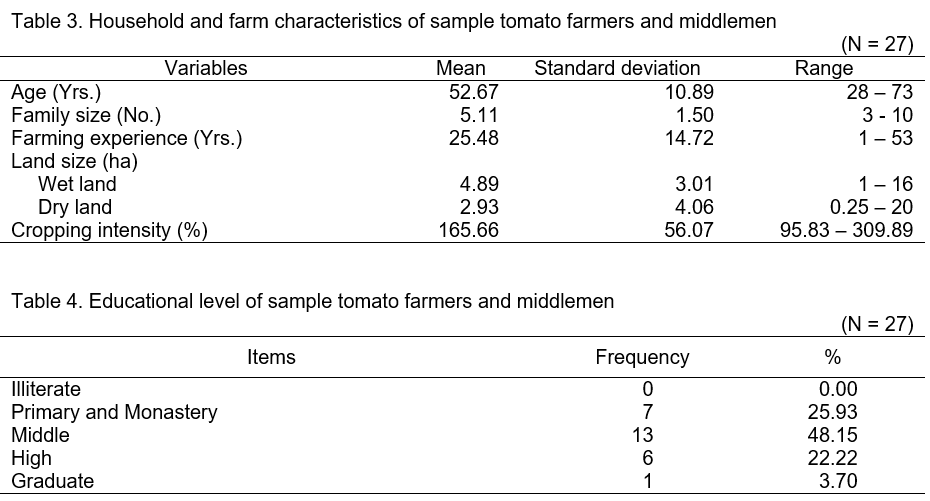
As shown in Table 5, Kyaukme (Traditional) variety was sown by 88.89% of sample respondents. Only three respondents (about 11.11%) cultivated 909 variety of tomato. About 88.89% of respondents chose the variety based on high yield, 70.37% based on market demanding variety, 48.15% based on quality and 44.44% based on pest and disease resistant variety.

-
Marketing activities of sample respondents
About 70.37% of samples sold their products directly to local wholesalers. The proportion of sample farmers who sold their products directly to primary collectors was about 33.33%. As a result of selling place, about 48.15% of respondents sold their products in the nearest market (Table 6). The average distance of nearest market to village is about 4.52 miles ranging from 0.8 mile to 9 miles and the nearest town is about 2.5 miles ranging from 1 to 4 miles.
Only 8 respondents have connection with marketing agents from other locations. The proportion of farmers connected with collector is the largest and it was about 11.11% (Table 6). The average number of contact buyer before first sale was 3.63 buyers and the range was from 0 to 20 buyers. The six respondents are not connected with the buyers before first sale. About 37.04% of respondents connected the buyers from town before selling their product (Table 6).
All respondents (100%) sold tomato immediately after harvesting as tomato is a perishable crop (Table 6). Cash down selling system was used by about 100% of respondents. Only one respondents (3.7%) practiced both of the cash down system and credit system. The weighting system used in selling tomato is viss (traditional Myanmar units of measurement – 1.63 kg). The cost for packaging tomato was paid by about 51.85 of farmers themselves. About 11.11% and 7.41% of respondents answered that the packaging cost was paid by local wholesaler and primary collector respectively. Although actors who pay for packaging were different, the packaging cost affected finally to the consumer price.
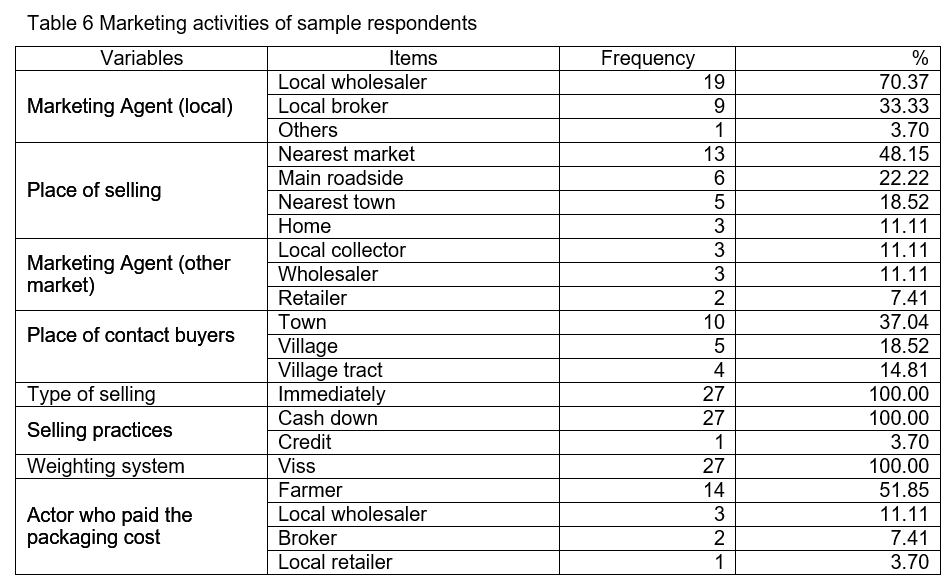
In selling tomato, local norms for selection of seed are shown in Table 7. Price of tomato is varied according to local norms. Color and size of tomato were the most important characteristics in standardizing and grading, which was assumed by 62.96% of respondents. The lowest proportion of about 3.70% of samples answered that purity was the important characteristics.

-
Mode of transportation for domestic trade flow by respondents
Table 8 describes mode of transportation of sample tomato farmers and middlemen for domestic trade flow. The proportion of respondents who transported the tomato to destination market by three-wheeled motorcycle was 62.96% and it was the highest percentage among the transportation vehicles. Two respondents did not give answer for transportation vehicles because the wholesaler bought the tomato at farmer’s home.
About 29.63% of the respondents sold the tomato by transporting from farm to nearest market. The selling system by transporting from home to nearest market was also practiced by 18.52% of the respondents. The proportion of the respondents who sold the tomato by transporting from farm to wholesale shop and from home to nearest town was 3.70% and it was the lowest proportion of respondents who practiced. The village is near to market and town, main road is convenient as well as the transportation vehicles are easy to access, so the respondents can easily and timely transport their products.

Domestic trade flow of tomato in Nay Pyi Taw
Domestic trade flow of tomato in Nay Pyi Taw Council Area is described as in Figure 1. As most of respondents in the study area lived near the town and market, they have an opportunity to sell directly to consumers. There were four market intermediaries for farmers: primary collector, local wholesaler, retailer and consumer.
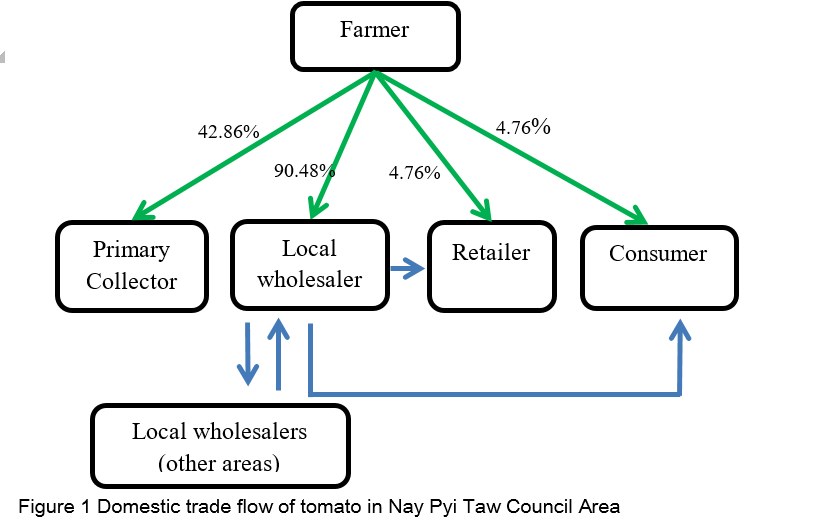
However, the highest proportion of respondents (90.48%) sold to local wholesalers. Although they could sell directly to consumers, the disciplines/ principle guideline set by Ahayathukha vegetable market (Nay Pyi Taw Vegetable Market) made it difficult for them to sell. Only 4.75% of farmers sold to consumers.
SWOT analysis for tomato production
-
Percentage contribution of respondents for SWOT analysis
Figure 2 represents strength factors contributing to the success of tomato production. The factors are scaled from 1 to 5 where 1 is not important and 5 is very important. High experience in production (4.30) and favorable place for tomato (4.19) was scaled between very high and high. Other strength factors that contributed between high and medium categories were domestic market demand (3.96), technical knowledge availability (3.56), good transportation (3.30), availability of machinery (3.04) and crop differentiation which means the possibility of different crops that can be grown (3.04). The medium and low strength of respondents was government assistance program (2.63). Demand for export (1.85) was ranged between the low and very low strength for respondents.
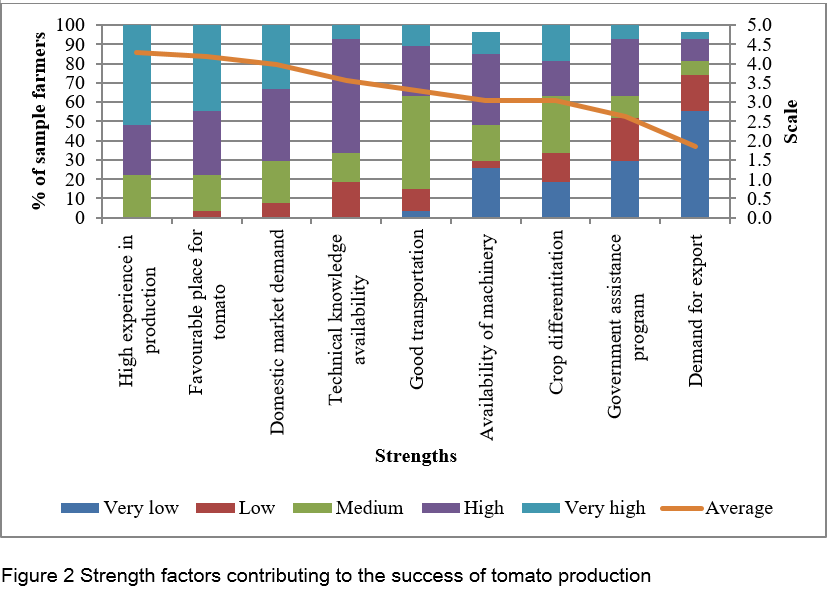
Figure 3 shows weakness factors contributing to the success of tomato production. The factors are scaled from 1 to 5 where 1 is not important and 5 is very important. The average number of high and very high weaknesses for respondents was not found. The highest average number of weakness was low yield and it was 4.04, therefore, it was ranged between very high and high weaknesses. The other weakness factors that contributed between high and medium were high cost of production (3.85), farmer oriented extension (3.59), weak market information (3.37), market opportunity and infrastructure (3.15) and limited resources (3.07). The low weakness factor was value added to process 2.00).

Figure 4 describes the opportunity factors contributing to the success of tomato production. The factors are scaled from 1 to 5 where 1 is not important and 5 is very important. There was no ranking among the eight opportunity factors falling in very low category. Diversification of crops (4.0) was scaled high as an average. Opportunity considered between high and medium categories was potential demand for tomato (3.04). Factors in the medium and low categories included: increasing information technologies (2.96), government support policy (2.70), advanced technology applied (2.70), increasing private industries related to agriculture (2.70), industry promotion program (2.52) and organic farming (2.15).
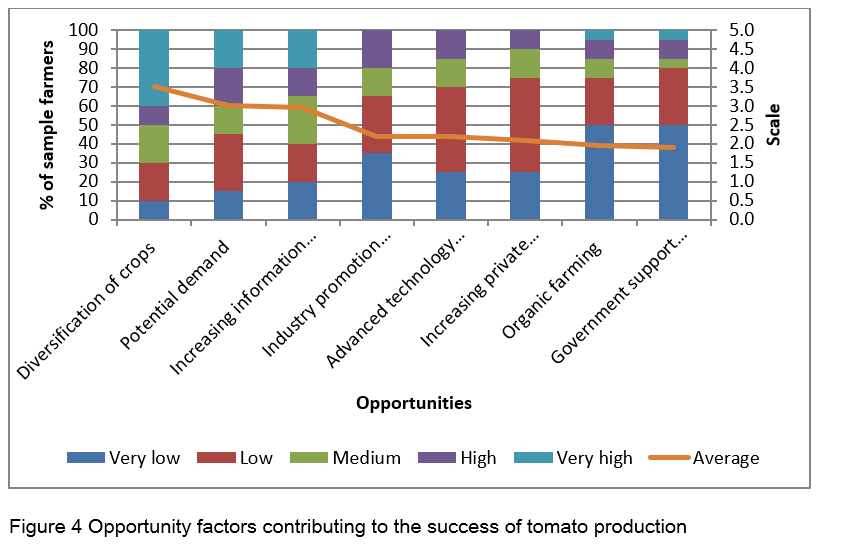
Figure 5 shows threat factors contributing to the success of tomato industry. The factors are scaled from 1 to 5 where 1 is not important and 5 is very important. Climate change (4.15) and marketing and price risks (4.1) were scaled between very high and high. The factors that contributed between high and medium were production risks (3.74), lack of quality seed (3.74), perishability of the products (3.56), declining interest due to migration (3.52), declining consumer demand (3.44), crop loss due to weed, insects and diseases (3.04). The factor considered between medium and low was poor agricultural policy (2.27). Lack of storage facilities (1.92) was the threat that ranked between low to very low.
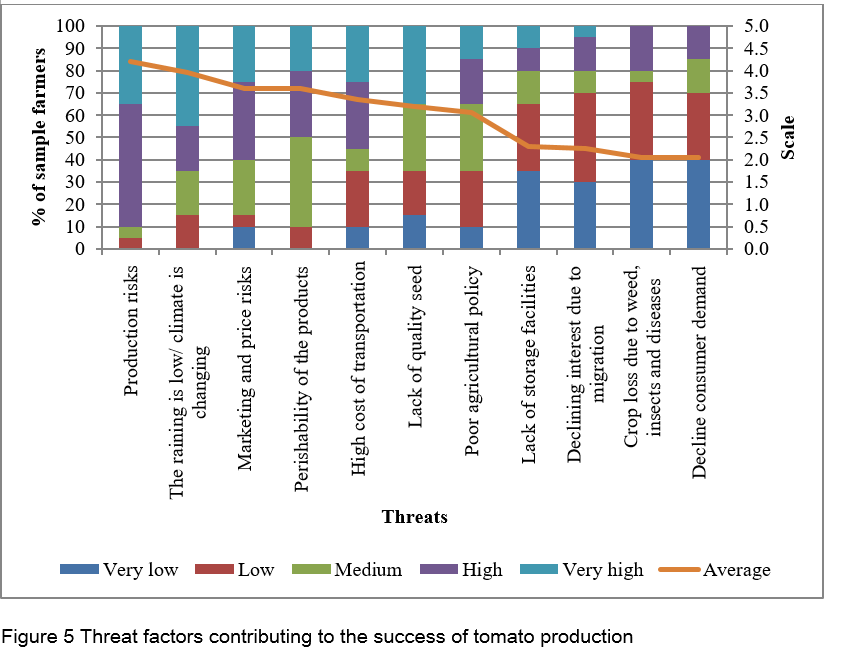
CONCLUSION AND RECOMMENDATION
The current situation in tomato production would be scaling up by necessary policy intervention areas in Myanmar. The critical intervention areas for tomato farmer livelihoods are recommended as follows.
- The most important need is the purity of seeds and modified quality seeds which should produce from domestic production with cheaper price than the varieties currently used in the study area. Alternately, in tomato, seed production is not for direct consumption and in order to maintain those seeds for cultivating in coming season production, the farmers require means to produce good quality seeds and storage facility.
- Second, farmers said that tomato leaf wilt disease can severely damage the tomato production and they need the systematic control measure of this disease. Therefore, farmers want the extension education for improved agro-techniques in tomato production.
- Other support program for farmers include the provision of investment capital as production credit due to the seed and agrochemical costs in tomato cultivation and the other one is cold storage facilities and infrastructure.
- Although, at present the tomato production and consumption is stable equilibrium in the domestic front, sometimes growers face surplus production due to the fact that many growers have the same planting time according to their different geographical conditions, which leads to low price of tomato. In this situation, not only the cold storage facilities but also the value-added processing techniques such as tomato juice, jam and sauce etc. are needed.
- The government should come up with a support program or intervention for tomato to have a more stable price in the market because the price of tomato in the market continues to change within the day.
REFERENCES
FAO (Food and Agriculture Organization of the United Nations). 2012. The State of Food and Agriculture, 2010–2012.
DALMS (Department of Agricultural Land Management and Statistics) 2017.Ministry of Agriculture and Irrigation, Nay Pyi Taw, Myanmar.


Participatory Policy Formulation of Tomato Value Chain in Nay Pyi Taw, Myanmar
ABSTRACT
Among the vegetables, tomato is considered the essential culinary crop and also an excellent source of many nutrients and secondary metabolites. In Myanmar, tomato is grown in about 112,525 ha with a total production of 1,300 thousand MT in 2016-2017. The study was done to observe the tomato production and marketing by using the strength, weakness, opportunity and threat (SWOT) analysis in Ottarathiri, and Dekkhinathiri Township in Nay Pyi Taw. Field survey to 20 tomato farmers and 7 market stakeholders was done in December 2017. Workshop for SWOT Analysis and Policy Dialogue together with all stakeholders was held at Yezin Agricultural University (YAU) on December 28, 2017. The sample respondents had an average of 25 years of experience in tomato production. Most of the respondents had middle education level. Kyaukme (Traditional) variety was sown by 89% of samples because of high yield. Farmers sold tomatoes directly to local wholesalers by connection with the buyers before selling the product. All sample farmers sold tomatoes immediately after harvesting with cash down payment system. The weighting system used in selling tomato is Viss (1 viss = 1.63kg). The cost for packaging was paid by farmers and local wholesaler. Color, size, cleanliness and moisture of tomato are the most important factors in standardizing and grading of tomato. Mode of transportation for trade of tomato was mainly by three wheeled motorcycle. The highest proportion of farmers directly sold their tomatoes to local wholesalers who distributed to retailer, local wholesalers from other areas and consumers. Strength factors of tomato production are high experience and favorable place. Weaknesses are low yield and high cost of production. Opportunity factors are: crops diversification and potential demand. The threat factors were climate change, marketing and price risks; perishability and declining interest to grow the product. The critical intervention areas for improving tomato farmer livelihoods are support to quality seeds, systematic control measure for diseases, and investment capital for cold storage, value-added processing techniques and market price stability program.
Keywords: Tomato, field survey, marketing, production, SWOT
INTRODUCTION
Tomato production in Myanmar
Fresh vegetables are an essential part of a healthy diet as it is an important source of vitamins and minerals. Myanmar is one of the agro-based countries in Asia and commercial crops of the country are cereals, vegetables and fruits. According to FAO (2012), the vegetable production in Asia has reached 240 MMT in 2012. Sixty seven percent of vegetables was produced by China and India which are the second largest vegetable producing countries in Asia. According to the data of Department of Agricultural Land Management and Statistics in 2017, the sown area of vegetables in Myanmar was gradually increased from 552,741 ha to 571,815 ha from 2013 to 2016. The vegetable production of 14,865 thousand MT in 2013-14 increased to 15,075 thousand MT in 2015-16. Yield per unit of vegetable was found instable among these consecutive three years (DALMS, 2017).
Among the vegetables, tomato is considered the essential culinary crop and also an excellent source of many nutrients and secondary metabolites. In Myanmar, tomato is being grown in about 112,525 ha for the total production of 1,300 thousand MT in 2016-2017 (Table 1) (DALMS, 2017). In Myanmar, there are two categories of tomato: high land and low land tomatoes. The former is well known as Shan tomato and the latter is called Myanmar tomato among consumers and traders. The main production areas for low land tomato are Pyinmana (Nay Pyi Taw Region), several areas of Magway Region, Monywa (Sagaing Region), Dike Oo and Binnar (Bago East Region) and Watpoke (Bago West Region). Tomato can be produced well in winter season and there is low yield in the summer and rainy season in Myanmar. Relatively cool temperature and drier condition of Southern Shan State is favorable for production of tomatoes in the whole year. High land tomato is grown in the Shan State especially in Inle Lake.
Objectives of the study
METHODOLOGY
Study sites selection for data collection
Nay Pyi Taw Union Territory consists of eight administrative townships: Pyinmana, Lewe, Tatkon, Ottarathiri, Dekkhinathiri, Pobbathiri, Zabuthiri and Zeyarthiri Townships (Department of population 2015). Ottarathiri, and Dekkhinathiri townships in Nay Pyi Taw Council Area were selected as the study areas. Selection of the study area focused on the ongoing Fostering Agricultural Revitalization in Myanmar IFAD-FARM project in order to develop the sustainable and scalable smallholders.
Data collection and analysis
To access the current marketing performance of tomato in Nay Pyi Taw, field survey for primary data collection was undertaken in December 2017. For primary survey, total sample size was 20 tomato farmers, and 7 market intermediaries along the production and marketing channels. First survey was done with 20 tomato growers and second survey was done with 7 intermediaries of tomato (Table 2).
Data were collected for the investigation of demographic and socio-economic conditions and marketing activities, marketing cost, marketing margin of various stakeholders, marketing channels and constraints and challenges and possible solutions. The market related questionnaire was used to collect farm level detailed measures of prices and quantity, purchased and sold system, marketing costs of various stakeholders’, storage facilities, transport facilities, access to market information.
The collected data and outputs were digitized collated and transmitted. The quantitative data were entered into a pre-defined format to assess outcomes. For the quantitative analysis, the data were analyzed through SPSS statistical software to obtain results.
Workshop for SWOT analysis and policy dialog to formulate policy implication
To establish a regional and national network for Value Chain and Market System Development with strong national partners (India, Bangladesh, China, Vietnam, Indonesia, Laos, and Myanmar), IFAD’s support to build capacities of implementing agencies for value chain programs started from 2016-2020. Under this network, on December 28, 2017 a workshop was organized that brought together stakeholders to discuss the emerging issues in value chain, agriculture policy and implementation. The objectives of this stakeholder’s workshop were: to discuss the findings of the value chain study and formulation of policy implication for solving the bottlenecks with the participation of related stakeholders. The workshop was held at the YAU, Myanmar on December 28, 2017. In the workshop, there was a total of 28 participants including 4 Knowledge center staff from FARM project, each of 10 tomato farmers and 3 of market intermediaries, 11 of agricultural economics master students and teachers. The workshop was arranged with discussion and formulation about value chain upgrading process, intervention areas to overcome the weaknesses and threats of selected crops by group participation. Based on the opinions for improvement of current situation of the value chains of fresh tomato, the opinions were firstly analyzed by SWOT analysis and conclusion was done for critical intervention areas.
RESULTS AND DISCUSSION
Tomato farmers in Nay Pyi Taw Council Area
Demographic characteristics of sample tomato farmers and middlemen
Average age of sample respondents was 52.67 years with a standard deviation of 10.89. The interviewed households had family size ranging from 3 to 10 and the average was 5.11 persons. The sample farmers had an average of 25.48 years of experience in tomato production, ranging from 1 to 53 years. The sample farmers owned an average 4.89 ha of wet land and 2.93 ha of dry land. The range of land size was 1 to 16 ha in both wet land and dry land, meaning that most farmers had both wet land and dry land. The average cropping intensity was 165.66%, ranging from 95.83% to 309.89% (Table 3). Therefore, some farmers had high cropping intensity for their farm land.
Education level of the sample respondents were categorized into five groups. “Illiterate education level” means they cannot read and write. “Monastery education level” defines informal schooling that the farmers can read and write or primary formal schooling up to 5 years, so monastery and primary education level are assumed as one group. Middle education level is described for formal schooling up to 9 years and formal schooling up to 11 years is high school education level. The last graduate education level refers to those who had educational degree from university. The education level of farmers was assumed to determine the decision making of their farming system. In the study area, there was no illiterate and graduate education level. Most of the respondents had middle education level and it was about 48.15% of total respondents (Table 4).

As shown in Table 5, Kyaukme (Traditional) variety was sown by 88.89% of sample respondents. Only three respondents (about 11.11%) cultivated 909 variety of tomato. About 88.89% of respondents chose the variety based on high yield, 70.37% based on market demanding variety, 48.15% based on quality and 44.44% based on pest and disease resistant variety.
Marketing activities of sample respondents
About 70.37% of samples sold their products directly to local wholesalers. The proportion of sample farmers who sold their products directly to primary collectors was about 33.33%. As a result of selling place, about 48.15% of respondents sold their products in the nearest market (Table 6). The average distance of nearest market to village is about 4.52 miles ranging from 0.8 mile to 9 miles and the nearest town is about 2.5 miles ranging from 1 to 4 miles.
Only 8 respondents have connection with marketing agents from other locations. The proportion of farmers connected with collector is the largest and it was about 11.11% (Table 6). The average number of contact buyer before first sale was 3.63 buyers and the range was from 0 to 20 buyers. The six respondents are not connected with the buyers before first sale. About 37.04% of respondents connected the buyers from town before selling their product (Table 6).
All respondents (100%) sold tomato immediately after harvesting as tomato is a perishable crop (Table 6). Cash down selling system was used by about 100% of respondents. Only one respondents (3.7%) practiced both of the cash down system and credit system. The weighting system used in selling tomato is viss (traditional Myanmar units of measurement – 1.63 kg). The cost for packaging tomato was paid by about 51.85 of farmers themselves. About 11.11% and 7.41% of respondents answered that the packaging cost was paid by local wholesaler and primary collector respectively. Although actors who pay for packaging were different, the packaging cost affected finally to the consumer price.
In selling tomato, local norms for selection of seed are shown in Table 7. Price of tomato is varied according to local norms. Color and size of tomato were the most important characteristics in standardizing and grading, which was assumed by 62.96% of respondents. The lowest proportion of about 3.70% of samples answered that purity was the important characteristics.
Mode of transportation for domestic trade flow by respondents
Table 8 describes mode of transportation of sample tomato farmers and middlemen for domestic trade flow. The proportion of respondents who transported the tomato to destination market by three-wheeled motorcycle was 62.96% and it was the highest percentage among the transportation vehicles. Two respondents did not give answer for transportation vehicles because the wholesaler bought the tomato at farmer’s home.
About 29.63% of the respondents sold the tomato by transporting from farm to nearest market. The selling system by transporting from home to nearest market was also practiced by 18.52% of the respondents. The proportion of the respondents who sold the tomato by transporting from farm to wholesale shop and from home to nearest town was 3.70% and it was the lowest proportion of respondents who practiced. The village is near to market and town, main road is convenient as well as the transportation vehicles are easy to access, so the respondents can easily and timely transport their products.
Domestic trade flow of tomato in Nay Pyi Taw
Domestic trade flow of tomato in Nay Pyi Taw Council Area is described as in Figure 1. As most of respondents in the study area lived near the town and market, they have an opportunity to sell directly to consumers. There were four market intermediaries for farmers: primary collector, local wholesaler, retailer and consumer.
However, the highest proportion of respondents (90.48%) sold to local wholesalers. Although they could sell directly to consumers, the disciplines/ principle guideline set by Ahayathukha vegetable market (Nay Pyi Taw Vegetable Market) made it difficult for them to sell. Only 4.75% of farmers sold to consumers.
SWOT analysis for tomato production
Percentage contribution of respondents for SWOT analysis
Figure 2 represents strength factors contributing to the success of tomato production. The factors are scaled from 1 to 5 where 1 is not important and 5 is very important. High experience in production (4.30) and favorable place for tomato (4.19) was scaled between very high and high. Other strength factors that contributed between high and medium categories were domestic market demand (3.96), technical knowledge availability (3.56), good transportation (3.30), availability of machinery (3.04) and crop differentiation which means the possibility of different crops that can be grown (3.04). The medium and low strength of respondents was government assistance program (2.63). Demand for export (1.85) was ranged between the low and very low strength for respondents.
Figure 3 shows weakness factors contributing to the success of tomato production. The factors are scaled from 1 to 5 where 1 is not important and 5 is very important. The average number of high and very high weaknesses for respondents was not found. The highest average number of weakness was low yield and it was 4.04, therefore, it was ranged between very high and high weaknesses. The other weakness factors that contributed between high and medium were high cost of production (3.85), farmer oriented extension (3.59), weak market information (3.37), market opportunity and infrastructure (3.15) and limited resources (3.07). The low weakness factor was value added to process 2.00).
Figure 4 describes the opportunity factors contributing to the success of tomato production. The factors are scaled from 1 to 5 where 1 is not important and 5 is very important. There was no ranking among the eight opportunity factors falling in very low category. Diversification of crops (4.0) was scaled high as an average. Opportunity considered between high and medium categories was potential demand for tomato (3.04). Factors in the medium and low categories included: increasing information technologies (2.96), government support policy (2.70), advanced technology applied (2.70), increasing private industries related to agriculture (2.70), industry promotion program (2.52) and organic farming (2.15).
Figure 5 shows threat factors contributing to the success of tomato industry. The factors are scaled from 1 to 5 where 1 is not important and 5 is very important. Climate change (4.15) and marketing and price risks (4.1) were scaled between very high and high. The factors that contributed between high and medium were production risks (3.74), lack of quality seed (3.74), perishability of the products (3.56), declining interest due to migration (3.52), declining consumer demand (3.44), crop loss due to weed, insects and diseases (3.04). The factor considered between medium and low was poor agricultural policy (2.27). Lack of storage facilities (1.92) was the threat that ranked between low to very low.

CONCLUSION AND RECOMMENDATION
The current situation in tomato production would be scaling up by necessary policy intervention areas in Myanmar. The critical intervention areas for tomato farmer livelihoods are recommended as follows.
REFERENCES
FAO (Food and Agriculture Organization of the United Nations). 2012. The State of Food and Agriculture, 2010–2012.
DALMS (Department of Agricultural Land Management and Statistics) 2017.Ministry of Agriculture and Irrigation, Nay Pyi Taw, Myanmar.